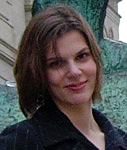The shooting death last Saturday of Neda Agha-Soltan has emerged, thanks to video widely circulated on the Internet, as a potent symbol of Iran’s antigovernment movement. In the news media and in private postings across the Web, Agha-Soltan has been memorialized as a victim, a martyr and — perhaps most hauntingly to Western ears — as “Iran’s Joan of Arc.”
Yet while fitting in some ways, that comparison says less about either Agha-Soltan or the 15th-century French saint than it does about our own need to make sense of the present through comparison with the past, says Julie Singer, Ph.D., assistant professor of French in the Department of Romance Languages & Literatures at Washington University in St. Louis.

“At first glance the comparison seems apt enough,” explains Singer, a medieval scholar who teaches a seminar on the cultural memory of Joan of Arc. “Both were young women (Joan was 19 at her death in May 1431, Neda was 26); each appears to have died for her political stance; both were popularly acclaimed as martyrs; both women’s stories have become fodder for royalist and/or anti-theocratic movements.
“But Reza Pahlavi is not King Charles VII, and Neda Agha-Soltan may simply have been a bystander trying to escape the heat of a car stuck in Tehran traffic. We must remember, too, that while in the age of instant internet gratification stories like Neda’s can become potent international symbols in a matter of hours, Joan’s transformation from heretic to saint was considerably less smooth. It was 25 years from Joan’s execution to her official exoneration; and this most celebrated martyr, who died on May 30th, 1431, was only canonized in 1920.
“To my mind, the more interesting question is why we feel compelled to make such comparisons at all. What does this gesture say about our relationship with the past? The epithet ‘Iran’s Joan of Arc’ is illustrative of a broader tendency to turn distant historical periods into sets of stock figures whom we then understand by diagnosing them (‘Joan was schizophrenic!’) or by updating them via comparisons to more familiar people, places, and events. A complex personage like Joan of Arc, when flattened in such a manner, is easily assigned to the ‘right’ or ‘wrong’ side of history. She becomes an easy shorthand for the politically conscious citizens whom Obama characterized in his Tuesday press conference as ‘those who stand up for justice.’
“Finally, the instantaneous ubiquity of the comparison between Neda and Joan is suggestive of a certain process of translation that often takes place when the media consumer attempts to relate to chronologically or geographically distant people and events. Like that of Yoo Kwon Sun — the ‘Korean Joan of Arc,’ killed in 1920 during the Japanese occupation — Neda Agha-Soltan’s senseless death is imparted a political significance through comparison with a long-dead teenager whose story is but vaguely familiar to most people today. Indeed, such comparison implies a need to bring contemporary Iran’s political struggles into the Western symbolic canon in order to valorize or even comprehend them.”
Singer’s research focuses on medieval French and Italian literature and culture; particular interests include literature and medicine, the cultural history of science and technology and disability studies. In addition to Joan of Arc, Singer’s seminars have explored clothing and disguise in Old French literature and representations of the body and disability in the Middle Ages. She is currently at work on a book project exploring 13th-, 14th-and 15th-century poetic constructs of the body, specifically of the eyes and blindness, and the literary remedies that challenge medical/surgical models and methods.
Editor’s Note: Professor Singer is available for live or taped interviews using Washington University’s free VYVX or ISDN lines. Please contact Liam Otten at (314) 935-8494, liam_otten@wustl.edu, for assistance.